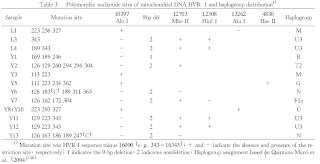 From the paper:
From the paper:Physical anthropology of Shao et al. revealed that the ancient human bones from Sampula exhibited primarily Mongoloid characteristics with certain European features, but Han et al. believed that Sampula populations are mainly of European character and actually are close to that of the Eastern Mediterranean type.
...
In conclusion, the analysis of mtDNA haplogroup distribution showed that the ancient Sampula was a complex population of European and Asian, corresponding to the physical anthopology result of Shao et al.
Progress in Natural Science, Volume 17, Issue 8 August 2007 , pages 927 - 933
Mitochondrial DNA analysis of ancient Sampula population in Xinjiang
Chengzhi Xie et al.
Abstract
The archaeological site fo Sampula cemetery was located about 14 km to the southwest of the Luo County in Xinjiang Khotan, China, belonging to the ancient Yutian kingdom. 14C analysis showed that this cemetery was used from 217 B.C. to 283 A. D. Ancient DNA was analysed by 364 bp of the mitochondrial DNA hypervariable region 1 (mtDNA HVR-1), and by six restriction fragment length polymorphism (RFLP) sites of mtDNA coding region. We successfully extracted and sequenced intact stretches of maternally inherited mtDNA from 13 out of 16 ancient Sampula samples. The analysis of mtDNA haplogroup distribution showed that the ancient Sampula was a complex population with both European and Asian Characteristics. Median joining network of U3 sub-haplogroup and multi-dimensional scaling analysis all showed that the ancient Sampula had maternal relationship with Ossetian and Iranian.
Link

2 comments:
What's the overall distribution of U3? AFAIK it's most important in the southern coasts of the Black Sea specially. Wikipedia only mentions 6% in the Caucasus but I've seen references (Torroni?, Richards?, not sure right now) that it's important in Turkey and Bulgaria too (and probably where the north/western Roma got it before migrating out of the Balcans).
Instead it seems low in Central Asia overall (Wikipedia: 1%).
I ask because it's the obvious more important single clade (4/13) among these remains, and a very specific one. Would it be U5 it would be less intriguing - but U3 is food for thought. Specially because Western clades in this population should be of Tocharian origin with great likehood. The only other Western clade is T2 (one case).
Oops, never mind. It's already replied in the abstract (silly me!): Median joining network of U3 sub-haplogroup and multi-dimensional scaling analysis all showed that the ancient Sampula had maternal relationship with Ossetian and Iranian.
Scythian-like then, I guess.
Post a Comment